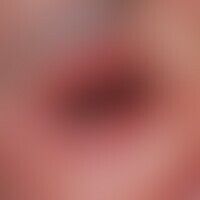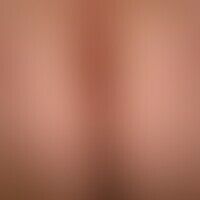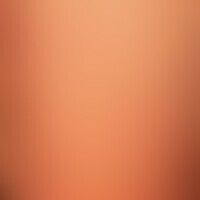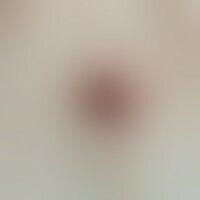Image diagnoses for "red"
901 results with 4543 images
Results forred

Acrodermatitis chronica atrophicans L90.4
Acrodermatitis chronica atrophicans. general view: livid, unscnarf limited, brownish-red spots on the left hand. skin in the area of the ball of the thumb atropical, finely wrinkled, with fine-lamellar scaling.

Subcorneal pustular dermatosis (Sneddon-Wilkinson) L13.1
Pustulose, subcorneal. 6-year-old boy with infantile form of the disease. Craniocaudal erupted pustules after fever attack, disseminated over the whole integument. Whole integument almost completely reddened, flat flat infiltrations of the skin with fine lamellar scaling.

Dermatitis medusica L24.8
Dermatitis medusica: A few minutes after the contact event, representation of linear, strongly consistency-multiplied, flat-exposed plaque with scab and vesicle formation (illustration was kindly provided by Dr. Heike Luther/Essen).

Dyskeratosis follicularis Q82.8
Dyskeratosis follicularis: Infestation of the palms of the hands; in central areas of the palm flat, common keratoses, at the ball of the thumb about 0.1-0.2 cm large, glassy papules.

Adult dermatomyositis M33.1
Dermatomyositis: Acute bilateral lid edema with blurred symmetrical eythema, general fatigue, muscle weakness.

Lichen planus (overview) L43.-
Lichen planus of the capillitium: several atrophic plaques with discrete hair thinning.

Keratoakanthoma (overview) D23.-
Keratoakanthoma classic type: side view of the prescribed keratokanthoma.

Hematoma T14.03
Haematoma: not quite fresh haematoma of the shoulder region after a fall; blurred boundaries of the discoloration.

Parapsoriasis en plaques benign small foci L41.3
Parapsorisis en petites plaques: completely symptom-free red (hardly palpable), slightly scaly plaques; recurrent course for years; improvement in the summer months or under UV therapy.

Guttate psoriasis L40.40
psoriasis guttata. small, exanthematic form of psoriasis after streptococcal infection. only slight scaling (due to pre-treatment). note the indicated linear patterns (koebner phenomenon). the auspitz phenomenon (finest punctiform bleeding after removal of the uppermost scaly layer with a wooden spatula) can still be triggered even in these pre-treated lesions and is therefore an excellent diagnostic sign (best triggered in the small papules).

Acne inversa L73.2
Acne inversa: severe clinical, therapy-resistant finding in a 52-year-old female patient. existing since the age of 20. conspicuous sausage-shaped scar strands.













